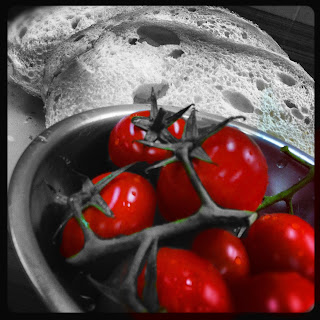 |
| Image by Taylor S |
This term we are studying core strand 2:
Food Quality. This unit of the syllabus investigates hygienic food handling, safe storage of food, food presentation, sensory characteristics of food as well as the functional properties of food. How does one safely handle a protein product or store a perishable food item? For how long? What is the difference between use-by-dates and best before dates? How do certain factors such as oxygen, temperature and acidity affect food? Does effective food presentation appeal to you? What is effective food preparation? The answers to these and many more questions are investigated throughout the term.
 |
| Image by Jacob B |
 |
| Using Jacob's image we applied Aquarell on Autopainter ap |
 |
| Image by Mrs James |
Mobile technology has increasingly become part of our daily lives; especially for youth. They live and interact in a densely connected world. These online connections are occurring more and more via mobile devices.
Experiences are captured in a photo and shared instantly on Facebook, tumbler or instagram in a blink of an eyelid. There has been negative views regarding social networking in the media, which can often overshadow the
positive elements of these communities. Immersing yourself in these worlds one can find a great sense of
belonging and
affirmation. It is a place to
reflect and start conversations. For some, it offers a
haven from challenging face to face relationships. One can obtain an avatar and experiment with a person they hope to one day become. For others,
opportunities exist to foster hobbies and interests. Gaining
support and
guidance from a wide variety of friends can be very beneficial.
Feedback is timely and immediate. Of course, our
youth must be supported in developing their digital identity and it is pleasing to see more schools taking an active and more importantly, proactive position towards digital education! The majority of kids are good at heart and will give things a go; if they see value in it.
Social networking, used in education is where the kids want to be.
They are already there socially,
so let's embrace it!
 |
| Image by Mrs James |
 |
| Image by Julian S |
 |
| Image by Jordan S |
Using a photo sharing app such as
Instagram, enables the user to tap into other peoples worlds. It also allows others to tap into ours. This sense of connection is wonderful! Instagram blends beautifully, the world of sharing photos with the world of
appreciation. Photographers have always had a eye for that special moment, accompanied with just the right angle to elicit certain emotions and memories. Using instagram allows the student to start thinking about the way in which they view the world. As others "like" and "comment" on their image they begin to gain confidence and experiment with the world of imagery.
We are using Instagram to capture the world of food. Food photography is a major player in
communicating messages to the consumer. From the image on a product trying to gain attention on a supermarket shelf to the
stunning dish on the cover of a gourmet food magazine that
intices you to want more! Over the next few weeks Year 11 Food Technology will be dabbling in food styling and photography as we learn about the functions and properties of food.
We are posting all our images on our instagram account "foodatoakhill" We have a twitter handle by the same name
@foodatoakhill If you like an image or could offer the student photographer advice, please do! The students are enjoying this exercise and love feedback and encouragement ;)
 |
| Image by Mrs James |
Instagram is available as an app on the ipad, iphone AND android devices. On a mac, you can view via INKSTAGRAM (some pics spaces are filled with advertisements, but not intrusive)
Click here for our instgram food via inkstagram. At this stage, you cannot view Instagram on your PC.
We are using other mobile apps such as
Snapseed, Frame magic,
Camera+ and
photoforge2. Snapseed is the most expensive at just over $5, the others are 0.99cents (Australian dollars). There are other free apps to use such as
Adobe photoshop express
(Other images will be posted in gallery over the course of the term-click on the tab above)
Next post:
Using QR codes to link students to information -at their fingertips, anytime; anywhere!
Enjoy the world of food! What are your favourite apps? What food would you like to see us photograph? Any tips or advice would be great! if you are food photographer or stylist and would love to share your expertise with our students, please get in touch!
Post comment:
Thank you for all the people that have viewed our blog and an extra HUGE thanks to those that take the time to "comment feedback" -so good to see!








































